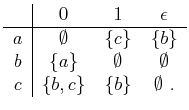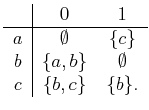
Next: 11.3.3 The Probabilistic Case: Up: 11.3 Examples for Discrete Previous: 11.3.1 Basic Nondeterministic Examples
An interesting connection lies between the ideas of this chapter and the theory of finite automata, which is part of the theory of computation (see [462,891]). In Section 2.1, it was mentioned that determining whether there exists some string that is accepted by a DFA is equivalent to a discrete feasible planning problem. If unpredictability is introduced into the model, then a nondeterministic finite automaton (NFA) is obtained, as depicted in Figure 11.8. This represents one of the simplest examples of nondeterminism in theoretical computer science. Such nondeterministic models serve as a powerful tool for defining models of computation and their associated complexity classes. It turns out that these models give rise to interesting examples of information spaces.
 |
An NFA is typically described using a directed graph as shown in
Figure 11.8b, and is considered as a special kind of finite
state machine. Each vertex of the graph represents a state, and edges
represent possible transitions. An input string of finite
length is read by the machine. Typically, the input string is a
binary sequence of 0's and ![]() 's. The initial state is designated by
an inward arrow that has no source vertex, as shown pointing into
state
's. The initial state is designated by
an inward arrow that has no source vertex, as shown pointing into
state ![]() in Figure 11.8b. The machine starts in this state
and reads the first symbol of the input string. Based on its value,
it makes appropriate transitions. For a DFA, the next state must be
specified for each of the two inputs 0 and
in Figure 11.8b. The machine starts in this state
and reads the first symbol of the input string. Based on its value,
it makes appropriate transitions. For a DFA, the next state must be
specified for each of the two inputs 0 and ![]() from each state.
From a state in an NFA, there may be any number of outgoing edges
(including zero) that represent the response to a single symbol. For
example, there are two outgoing edges if 0 is read from state
from each state.
From a state in an NFA, there may be any number of outgoing edges
(including zero) that represent the response to a single symbol. For
example, there are two outgoing edges if 0 is read from state ![]() (the arrow from
(the arrow from ![]() to
to ![]() actually corresponds to two directed edges,
one for 0 and the other for
actually corresponds to two directed edges,
one for 0 and the other for ![]() ). There are also edges designated
with a special
). There are also edges designated
with a special ![]() symbol. If a state has an outgoing
symbol. If a state has an outgoing
![]() , the state may immediately transition along the edge
without reading another symbol. This may be iterated any number of
times, for any outgoing
, the state may immediately transition along the edge
without reading another symbol. This may be iterated any number of
times, for any outgoing ![]() edges that may be encountered,
without reading the next input symbol. The nondeterminism arises from
the fact that there are multiple choices for possible next states due
to multiple edges for the same input and
edges that may be encountered,
without reading the next input symbol. The nondeterminism arises from
the fact that there are multiple choices for possible next states due
to multiple edges for the same input and ![]() transitions.
There is no sensor that indicates which state is actually chosen.
transitions.
There is no sensor that indicates which state is actually chosen.
The interpretation often given in the theory of computation is that
when there are multiple choices, the machine clones itself and one
copy runs each choice. It is like having multiple universes in which
each different possible action of nature is occurring simultaneously.
If there are no outgoing edges for a certain combination of state and
input, then the clone dies. Any states that are depicted with a
double boundary, such as state ![]() in Figure 11.8, are called
accept states. When the input string ends, the NFA is said to
accept the input string if there exists at least one alternate
universe in which the final machine state is an accept state.
in Figure 11.8, are called
accept states. When the input string ends, the NFA is said to
accept the input string if there exists at least one alternate
universe in which the final machine state is an accept state.
The formulation usually given for NFAs seems very close to Formulation 2.1 for discrete feasible planning. Here is a typical NFA formulation [891], which formalizes the ideas depicted in Figure 11.8:
 |
(11.47) |
Now consider reformulating the NFA and its acceptance of strings as a
kind of planning problem. An input string can be considered as a plan
that uses no form of feedback; it is a fixed sequence of actions. The
feasible planning problem is to determine whether any string exists
that is accepted by the NFA. Since there is no feedback, there is no
sensing model. The initial state is known, but subsequent states
cannot be measured. The history I-state ![]() at stage
at stage ![]() reduces
to
reduces
to
![]() , the action history.
The nondeterminism can be accounted for by defining nature actions
that interfere with the state transitions. This results in the
following formulation, which is described in terms of Formulation
11.2.
, the action history.
The nondeterminism can be accounted for by defining nature actions
that interfere with the state transitions. This results in the
following formulation, which is described in terms of Formulation
11.2.
| (11.48) |
For expressing the planning task, it is best to use the
nondeterministic I-space
![]() from Section
11.2.2. Thus, each nondeterministic I-state,
from Section
11.2.2. Thus, each nondeterministic I-state,
![]() , is the subset of
, is the subset of ![]() that corresponds to the possible
current states of the machine. The initial condition could be any
subset of
that corresponds to the possible
current states of the machine. The initial condition could be any
subset of ![]() because
because ![]() transitions can occur from
transitions can occur from ![]() .
Subsequent nondeterministic I-states follow directly from
.
Subsequent nondeterministic I-states follow directly from ![]() . The
task is to compute a plan of the form
. The
task is to compute a plan of the form
| (11.49) |
The problem given in Formulation 11.3 is not precisely a
specialization of Formulation 11.1 because of the state
transition function. For convenience, ![]() was directly defined,
instead of explicitly requiring that
was directly defined,
instead of explicitly requiring that ![]() be defined in terms of nature
actions,
be defined in terms of nature
actions,
![]() , which in this context depend on both
, which in this context depend on both ![]() and
and
![]() for an NFA. There is one other small issue regarding this
formulation. In the planning problems considered in this book, it is
always assumed that there is a current state. For an NFA, it was
already mentioned that if there are no outgoing edges for a certain
input, then the clone of the machine dies. This means that potential
current states cease to exist. It is even possible that every clone
dies, which leaves no current state for the machine. This can be
easily enabled by directly defining
for an NFA. There is one other small issue regarding this
formulation. In the planning problems considered in this book, it is
always assumed that there is a current state. For an NFA, it was
already mentioned that if there are no outgoing edges for a certain
input, then the clone of the machine dies. This means that potential
current states cease to exist. It is even possible that every clone
dies, which leaves no current state for the machine. This can be
easily enabled by directly defining ![]() ; however, planning problems
must always have a current state. To resolve this issue, we could
augment
; however, planning problems
must always have a current state. To resolve this issue, we could
augment ![]() in Formulation 11.3 to include an extra dead state, which signifies the death of a clone when there are no
outgoing edges. A dead state can never lie in
in Formulation 11.3 to include an extra dead state, which signifies the death of a clone when there are no
outgoing edges. A dead state can never lie in ![]() , and once a
transition to a dead state occurs, the state remains dead for all
time. In this section, the state space will not be augmented in this
way; however, it is important to note that the NFA formulation can
easily be made consistent with Formulation 11.3.
, and once a
transition to a dead state occurs, the state remains dead for all
time. In this section, the state space will not be augmented in this
way; however, it is important to note that the NFA formulation can
easily be made consistent with Formulation 11.3.
The planning model can now be compared to the standard use of NFAs in the theory of computation. A language of an NFA is defined to be the set of all input strings that it accepts. The planning problem formulated here determines whether there exists a string (which is a plan that ends with termination actions) that is accepted by the NFA. Equivalently, a planning algorithm determines whether the language of an NFA is empty. Constructing the set of all successful plans is equivalent to determining the language of the NFA.
 |
(11.50) |
| (11.51) |
 |
(11.52) |
A basic theorem from the theory of finite automata states that for the
set of strings accepted by an NFA, there exists a DFA (deterministic)
that accepts the same set [891]. This is proved by
constructing a DFA directly from the nondeterministic I-space. Each
nondeterministic I-state can be considered as a state of a DFA. Thus,
the DFA has ![]() states, if the original NFA has
states, if the original NFA has ![]() states. The
state transitions of the DFA are derived directly from the transitions
between nondeterministic I-states. When an input (or action) is
given, then a transition occurs from one subset of
states. The
state transitions of the DFA are derived directly from the transitions
between nondeterministic I-states. When an input (or action) is
given, then a transition occurs from one subset of ![]() to another. A
transition is made between the two corresponding states in the DFA.
This construction is an interesting example of how the I-space is a
new state space that arises when the states of the original state
space are unknown. Even though the I-space is usually larger than the
original state space, its states are always known. Therefore, the
behavior appears the same as in the case of perfect state information.
This idea is very general and may be applied to many problems beyond
DFAs and NFAs; see Section 12.1.2
to another. A
transition is made between the two corresponding states in the DFA.
This construction is an interesting example of how the I-space is a
new state space that arises when the states of the original state
space are unknown. Even though the I-space is usually larger than the
original state space, its states are always known. Therefore, the
behavior appears the same as in the case of perfect state information.
This idea is very general and may be applied to many problems beyond
DFAs and NFAs; see Section 12.1.2
Steven M LaValle 2020-08-14